Area of a Parallelogram
The formula to calculate the area of a parallelogram is: $$ A = b \times h $$ where \( A \) represents the area, \( b \) is the length of the base, and \( h \) is the height, which is the perpendicular distance between the base and the opposite side.
The concept of the parallelogram’s area dates back to ancient Greek mathematicians like Euclid, who described various properties of parallelograms and other geometric figures in his famous book, "Elements."
A Practical Example
Let’s consider a parallelogram with a base of 5 meters and a height of 3 meters.
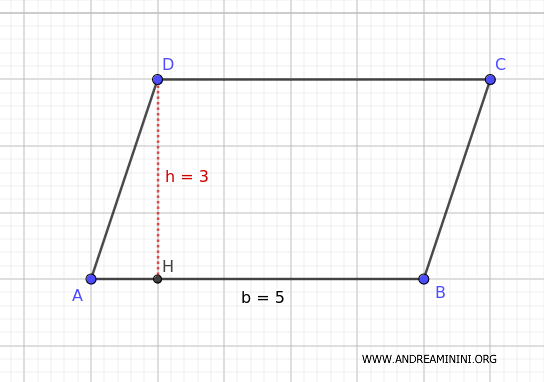
The area of the parallelogram is:
$$ A = 5 \, m \times 3 \, m = 15 \, m^2 $$
Explanation
To understand how this formula works, imagine transforming the parallelogram into a rectangle.
Draw the height inside the parallelogram, passing through vertex D.
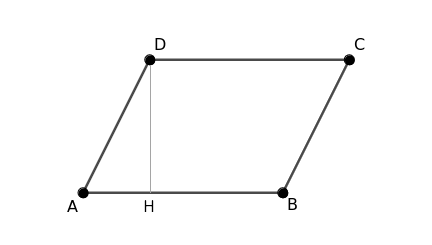
Now, cut along the triangle ADH and move it to the opposite side.
This creates a rectangle HDCE that has the same base and height as the original parallelogram.
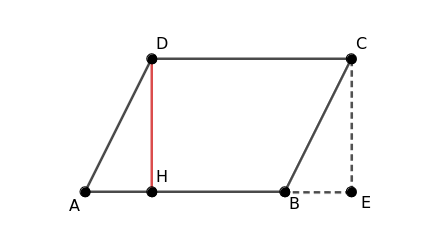
So, a parallelogram is equivalent to a rectangle with the same base and height.
Since the area of a rectangle is calculated by multiplying the base by the height, the same method applies to a parallelogram.
Calculating Area Using Cartesian Coordinates
An alternative method for finding the area of a parallelogram is by using the Cartesian coordinates of its vertices.
If the vertices of the parallelogram are given by the points \( (x_1, y_1) \), \( (x_2, y_2) \), \( (x_3, y_3) \), and \( (x_4, y_4) \), the area can be calculated using the determinant of the coordinates:
$$ A = \frac{1}{2} \left| x_1y_2 + x_2y_3 + x_3y_4 + x_4y_1 - (y_1x_2 + y_2x_3 + y_3x_4 + y_4x_1) \right| $$
Example
Let’s walk through an example of calculating the area of a parallelogram using the Cartesian coordinates of its vertices.
Suppose we have a parallelogram with vertices at the following coordinates:
$$ A (1, 2) $$
$$ B (4, 5) $$
$$ C (7, 4) $$
$$ D (4, 1) $$
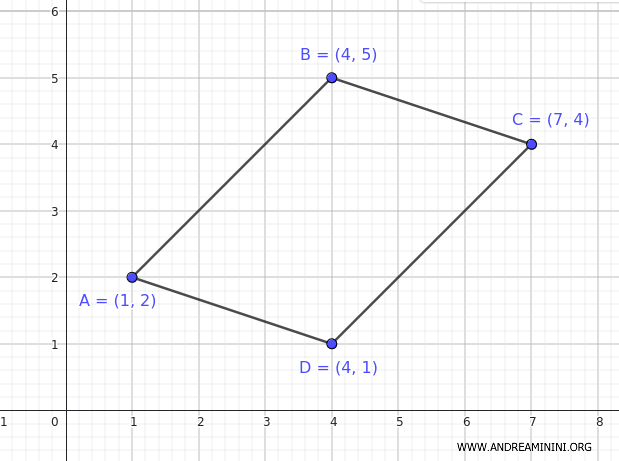
We list the coordinates in cyclic order:
$$ (x_1, y_1) = (1, 2) \\
(x_2, y_2) = (4, 5) \\
(x_3, y_3) = (7, 4) \\
(x_4, y_4) = (4, 1) $$
Now, we apply the determinant formula:
$$ A = \frac{1}{2} \left| x_1y_2 + x_2y_3 + x_3y_4 + x_4y_1 - (y_1x_2 + y_2x_3 + y_3x_4 + y_4x_1) \right| $$
Substituting the coordinates into the formula:
$$ A = \frac{1}{2} \left| 1 \cdot 5 + 4 \cdot 4 + 7 \cdot 1 + 4 \cdot 2 - (2 \cdot 4 + 5 \cdot 7 + 4 \cdot 4 + 1 \cdot 1) \right| $$
We calculate the individual products:
$$ A = \frac{1}{2} \left| 5 + 16 + 7 + 8 - (8 + 35 + 16 + 1) \right| $$
$$ A = \frac{1}{2} \left| 36 - 60 \right| $$
$$ A = \frac{1}{2} \left| -24 \right| $$
$$ A = \frac{1}{2} \cdot 24 $$
$$ A = 12 $$
The area of the parallelogram with vertices at the coordinates \( (1, 2) \), \( (4, 5) \), \( (7, 4) \), and \( (4, 1) \) is \( 12 \, \text{square units} \).
In fact, if you calculate the area of the parallelogram using the formula \( A = b \cdot h \), you also get A = 12.
$$ A = b \cdot h = 4.2426 \cdot 2.8284 = 12 $$
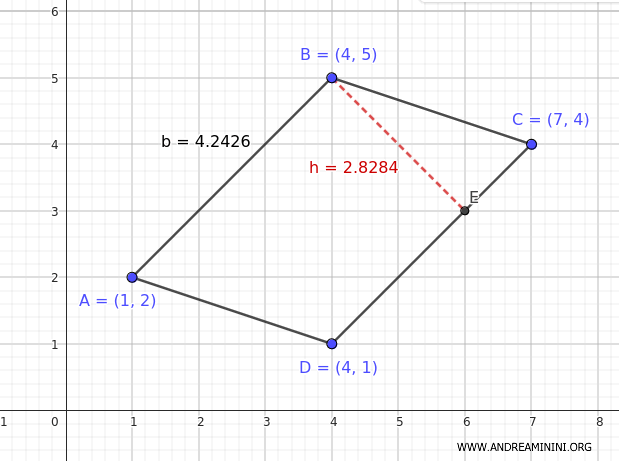
And so on.
